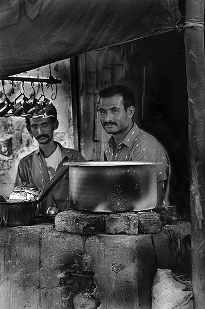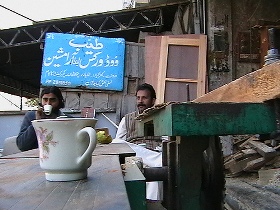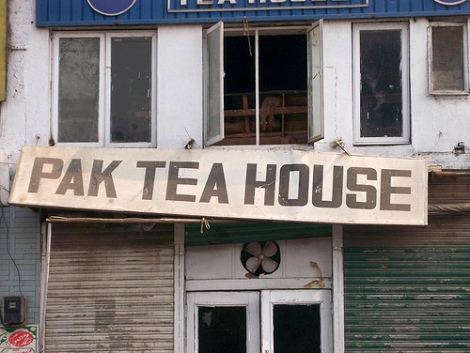Owais Mughal
Answer is US $220 million worth of it. Yes, it is true. Pakistan imported this much worth of tea in fiscal year 2006.
While years ago tea drinking used to be a fashionable habit, it is now our national habit, addiction and part of our evolutionary culture.  Part of our culture in a sense that guests are now offered tea as a minimum. Guests also expect a cup of tea as a minimum when they visit somebody. The cultural fusion of tea in our daily lives is so complete that I recently had to bear a beautiful wedding song sacrifced to our tea habit. The real song goes like this:
Part of our culture in a sense that guests are now offered tea as a minimum. Guests also expect a cup of tea as a minimum when they visit somebody. The cultural fusion of tea in our daily lives is so complete that I recently had to bear a beautiful wedding song sacrifced to our tea habit. The real song goes like this:
banno teray abba ki ooNchi haveli
banno meiN DhooNDta chala aaya
but during a song competition, groom’s side plagiarized the song to:
banno teray abba ka chai ka khokha
banno meiN khaulta chala aaya
If you go to any Pakistani commercial bazaar (market), you will notice that all shopkeepers drink tea en-masse atleast twice daily. There is a whole institution in place where cups full of tea are distributed in the whole market and then collected later on.  Tea is even offered on credit. One can choose from a variety of payment plans like ‘pay as you go’, pay weekly or monthly. Tea is also offered to prospective ‘gaahak’ (buyer) by the shopkeeper to show how sincere he/she is in upcoming transaction.
Tea is even offered on credit. One can choose from a variety of payment plans like ‘pay as you go’, pay weekly or monthly. Tea is also offered to prospective ‘gaahak’ (buyer) by the shopkeeper to show how sincere he/she is in upcoming transaction.
The $220 million amount seemed astronomical to me and it shocked me for few seconds and that is what prompted me to write these lines. Good or bad I don’t know because I myself contribute roughly $100 a year to this fashion. What to hide from you, I am sipping on a cup of tea even while writing these very lines. But after reading this number, I feel as if there is a brewing storm in my tea cup.
Fountain of Youth?
 But then all is not bad about tea. Tea contains antioxidants which are good for us. One of my good friends who recently did research on tea tells me that during digestion of food besides energy for our daily activities, high energy free oxygen radicals are also produced. These highly mobile particles hit DNA in the cells, thus causing severe damage to DNA. This in turn could lead to defects in DNA which is the primary cause of cancer. Antioxidants found in tea neutralize free Oxygen radicals thus minimizing damage to DNA and hence cancer.
But then all is not bad about tea. Tea contains antioxidants which are good for us. One of my good friends who recently did research on tea tells me that during digestion of food besides energy for our daily activities, high energy free oxygen radicals are also produced. These highly mobile particles hit DNA in the cells, thus causing severe damage to DNA. This in turn could lead to defects in DNA which is the primary cause of cancer. Antioxidants found in tea neutralize free Oxygen radicals thus minimizing damage to DNA and hence cancer.
A recent research published in a leading journal “Nature” shows that DNA damage can also lead to premature aging in humans, in addition to cancer. Therefore, each time when you sip from your cup of tea, think like you are sipping from fountain of youth.
There are reports that Government of Pakistan is now awakening to this massive demand of a massive population of 160 million Pakistanis. There are reports of a plan to grow tea locally in Pakistan on 4000 acres. This will be done in private sector. Semi Government sectors will also chip in by growing tea at 800 acres in NWFP, 200 acres in AJK and 50 acres in FATA. This will still be like putting ‘ooNT ke muNh meiN zeera’ (a single cumin seed in a camel’s mouth) but better than nothing.
There is another angle to this national addiction. It gives Pakistan a teeny-tiny leverage in World trade. I’ve read in news that when India and Pakistan were in serious trade negotiations in 2004, then of all the people, it made Government of Kenya very nervous. Kenya gets a big share of our US $220 million up-for-grabs money and they were probably wary of losing its share to India’s Assamese and Darjeeling produced black tea.
I personally like Darjeeling black tea over Kenyan brands but then who am I to decide about World trade. I’ll end the post with this plagiarized sher:
“chai” se gharz-e-nishaat hai kis rosiaah ko
ik gona-e-be-khudi mujhay har dum chahiyay
Pakistan’s National Tea Research Institute:
Pakistan has established a National Tea Research Institute in Mansehra which works under Pakistan Agricultural Research Council (PARC). The institute has a tea garden spread on 33 acres. Mansehra was chosen for tea research because of its hilly location with lots of rainfall. The web page of this tea research institute is here.ÂÂÂ
References:
(1) Photos for this post have been taken from flickr.com. Clicking on the photos will take you to their source website.
(2) Source of some of the information for this post is from here.
Previos ATP post on ‘chai’ (tea): Chai Chahiyay




















































Sridhar
Pakistan has no area that comes close to Assam, Darjeeling or Bangladesh-Tripura hills geaography. Mansehra-Abbotabad are the closest but they are still very dry compared to typical hill producing areas of the world. As I have appended my article above, there is a tea research institure set up in Mansehra.
Dear Nashus. You provided good insight on Chinese tea. We also covered some word-of-mouth-history of how tea got introduced in sub-continent in one of our earlier posts at:
http://pakistaniat.com/2006/08/05/guest-post-chai- cha-he-aye/
The reason Chinese can drink tea without milk or sugar is b/c it is very diluted. There is a mild taste of tea and they keep changing boiled water in it. What sub-continent people drink is a highly concentrated dose :) of multiple tea spoons of ‘patti’ in a kettle. This makes it so bitter that so far I have never dared to drink desi tea without milk/sugar.
No threat and no treat can keep me from my cup a tea.
must have three steaming mugs at breakfast, a cup of after noon tea, and until recently have developed a habit of brewing a warm cup of tea before going to bed, usually have my lunch and dinner at work and only thing i look forward to at my lonely apartment on return is a cup of tea with a piece of cake or something.
But the major trouble in my smooth habits is that not a single store here sells a decent belnd of tea, i have tried the most expansive cylone blends and imports from england too but they all tasted too lame as if i have boiled water furriuosly for hours with the minimum of tea leaves in it hoping to get a karak cha on the strength of heat only, Lipton yellow lablel lives up to the expectionations to some exctant but it too is not the real true yellow label sold back home.
Now i have started campaigning for my tea supplies and the friends coming over from pakistan are good enough to bring me kilo packs of yellow label.
Now my stocks are replensihed for another six months, and a happy bird flys home each night singing
yahi to hayyy
woh apna pan!!
I believe tea became popular in subcontinent not more than 80 years ago when tea companies offered free samples in cities and villages, their slogan was “Garmi mein garam chai thandak pohchanti hei”. The beverage had milk and sugar.
China where I have been for last 8 years has a rich tea culture. Tea is given as gifts in New Year. Some tea is more expensive than gold. There are a number of kinds of tea: Green teas, Gasmine tea, Oolong tea, Puer tea, eight treasure tea so on and on. Almost everyone consumes tea carrying a bottle all day in which boiled water is replenished. No milk or sugar in that tea. Now bottled tea is available with a slight sweet taste. Then there are tea candies and green tea ice cream. Since the opening up of China western beverages Coke, Pepsi, Starbucks have invaded China but chinese tea remains the most popular beverage.
In years I have developed the taste of chinese tea. However, recently while visiting Karachi I visited a friend at his office on II Chudrigar Road in the morning. As I was about to leave at around 10 am he asked me to stay as his tea from city station is about to arrive. Surprised at why should tea come from city station and not served from office canteen he told me to be patient. When the tea finally arrived I must say it had a unique taste which I wont ever forget.
When I was 16 a friend of mine told me that he stopped drinking tea after he learnt that Pakistan spends millions of rupees on tea import. On that day, 18 years ago, I gave up tea.